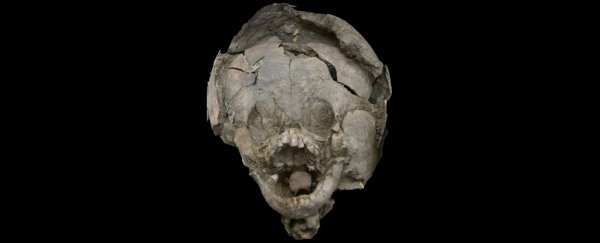Historical burial customs of children around the world often tend to be special, but every now and again, something really stops scientists in their tracks. An ancient burial just uncovered in Salango, Ecuador is a real doozy: two infants buried with their heads encased in the skulls of other children.
It is, the research team wrote, the first known instance of the use of children's skulls as mortuary headgear, anywhere, ever.
The remains were found as part of a funerary site excavation that took place between 2014 and 2016. In all, the dig turned up 11 individuals from the Guangala culture (not counting the helmet donors), dating back to roughly 2,600 to 2,100 years ago.
These were eight infants, two adults and a child, buried with an assortment of grave goods, with two more conventionally buried infants with stone figurines placed around their heads. Another two of the infants sported the unusual skull headgear.
"In this report, we present a mortuary tradition without known parallels," the researchers, led by anthropologist Sara Juengst of the University of North Carolina at Charlotte, wrote in their paper.
"Heads in South America have long been linked with ritual, symbolic, and real power, but these data from Salango present a highly specific mortuary practice in which the infant dead were interred wearing a 'helmet' made from crania of other children."
One of the infants was aged around 18 months old. Wrapped around its head was the skull of a child aged between 4 and 12 years. The second infant was between 6 and 9 months old, wearing the skull of a child aged between 2 and 12 years.
Cut marks and hinged straight edges on the headgear of the older infant suggested that the helmet had been crafted at or around the time of death of the child, and the baby's face was placed peering out of the cranial vault of the helmet. Both helmets were fitted very snugly around the infants' heads.
In addition, the researchers wrote, "It seems likely that the modified cranium was still fleshed when it was processed, due to the fact that the extra fragments were positioned in anatomical position, and juvenile crania often do not hold together, depending on the timing of cranial sutural fusion."
In other words, since the unfused skull plates were found in the right places, the team thinks there were still bits of soft tissue holding these skull 'helmets' together.
How the infants and children died is unclear - no trauma was recorded on either of the babies' remains. But the fact they were buried not long after a fall of volcanic ash, and the fact that the bones exhibit signs of malnutrition, could suggest that food was scarce in the wake of environmental disaster. Food scarcity and famine tend to hit the most vulnerable members of a community the hardest - infants and the elderly.
Of course, that is only speculative at this point, and more evidence would be needed to support such a hypothesis. The team is conducting DNA and isotope analysis, which may reveal more information.
As for the headgear, it's possible that it was part of a ritual response to the volcanic eruption, although this, too, is unclear.
What we do know is that heads were symbolically important to the Guangala people; and that children were often afforded special mortuary treatment as additional protection. So it's possible that's what was going on here.
The DNA and isotope analyses, the researchers hope, may also help to reveal more - whether the children whose skulls were crafted into helmets were related to the babies, for instance, and a precise date for the practice.
"The extra crania included with infant burials at Salango may represent an attempt to ensure the protection of these 'presocial and wild' souls. The surrounding of infant heads by stone ancestor figurines underscores this, indicating a concern with protecting and further empowering the heads," the researchers wrote.
"We hope that by reporting these burials, similar patterns may be identified in other contexts."
The research has been published in Latin American Antiquity.
